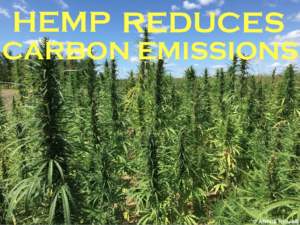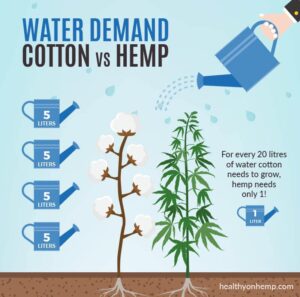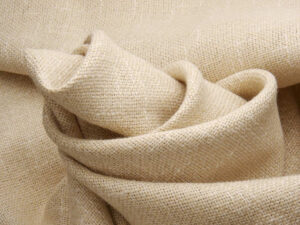When it comes to Hemp fabric, there is a negative connotation attached to it because of Marijuana. People often think of marijuana as hemp. But this is completely wrong. Both do have fundamental differences in their being. For centuries, humans have been using the hemp plant to create all sorts of products like oils, food, construction material, upholstery, and of course textiles.
1. Hemp Fabric sucks the carbon out of the air

We have been digging up carbon up from the earth and releasing it into the air for a very long time. After all these years of combustion, the earth getting warmer and warmer day by day. We all know that the only solution to this problem is sucking that extra carbon out of the atmosphere as soon as possible. The fashion industry is a great polluter. It contributes around 10% of global carbon pollution. But imagine if hemp fabrics were promoted and accepted like cotton? Farmers would plant hemp instead of cotton and it would become the largest growing plant in the world. The ability to absorb carbon from the air is the highest in hemp plants. The sudden increase in volume would definitely help the world decrease its carbon footprint.
2. Less water usage compared to cotton

Most of the natural fibers and synthetic fibers cause a lot of stress on our freshwater resources. The growing and processing of these fibers require a huge amount of water. Especially a fiber like cotton. From growing to finishing, it uses around 8000 – 1000 liters of water per kilo of cotton. Countries with the most sophisticated irrigation methods like the US also keep their water usage around 8000 liters per kilo of cotton. Besides, huge amounts of chemical fertilizers are also used in the production of these fabrics. Hemp is clearly a winner when it comes to growing and processing. It only uses a small amount of water. Hemp can be grown without much care and water. It also grows within a span of six months.
Read: Hemp fabrics are leading the sustainability trends
3. Soil health longevity
From a farmer’s perspective, growing hemp is a piece of cake. There are no additional expenses or harmful side effects for the environment just because of hemp farming. It grows in almost all types of soil. It doesn’t rob soil off of its nutrients or other properties. It is found out that hemp plants help restore some vital nutrients that might have been previously lost. A farmer can easily grow multiple cycles of a hemp plant on a single plot of land. To top these qualities, it is also biodegradable.
4. Anti-microbial properties
Hemp has long-lasting anti-microbial properties among any other textile fiber like cotton, polyester, etc. Hemp fibers are packed with excellent antimicrobial properties. It fights against microbes. Hemp clothes fight against odor-causing bacteria. For people with bad odors, hemp cloths are ideal to avoid them.
5. Naturally resistant to UV Rays
Hemp clothes have the highest thread count. It is a tightly woven material. The dangerous rays that are coming from the sun are blocked by hemp fabrics and it prevents them from touching your skin directly. Therefore keeping you protected from the harmful effects of UV rays.
No time to Read? Download the article!
6. Porous, hence breathable
Hemp is a natural fiber that has small pores when woven together. These tiny holes increase the air circulation between the body and the surrounding making it more breathable. The fibers are also lighter and do not cling to the skin. These properties make hemp fabrics an ideal solution for comfortable wear.
7. Luxury level comfort
Hemp clothes are incredibly comfortable to wear because of the qualities we discussed above. It is also stylish to wear. The amazing thing about hemp clothes is that it gets softer with every wash. Now that’s something amazing about clothing material.

8. Hemp fabric blends easily with other fibers
The hemp fibers can be blended with fibers without much difficulty. Mixing with other fibers enhances the properties of the hemp plant. It is commonly blended with cotton, modal, Tencel, bamboo, etc. in order to enhance the advantages. Since Hemp fabrics are slightly costlier because of the scarcity of farmers growing them, it is ideal to blend it with cheaper fibers in order to offer customers cheap fashion.
9. All-weather styling partner
Various types of clothing pieces are made with hemp. Full dresses, pants, jackets, skirts, children’s clothing, etc are made. The normal hemp fabrics are neither too thick nor too thin. One can easily wear it during summer because it feels comfortable. The flowy drape feels helps to look comfortable in them. During winters, the same clothes can be used for layering.
10. Highly durable
Hemp fiber ranks top among the strongest fibers in the world. It is four times stronger than cotton. Researchers have found that hemp fibers can take a lot of damage and bear more weight. It is an ideal fabric for outdoor-ish products. These fibers are spun in a very unique manner because it stays clean and fresh for a very long time.
11. Naturally pigmented

Hemp fabric is naturally gifted with a unique color grade. It has a very beautiful natural color. These shades are often confused with organic dye by various designers and consumers.
12. Hemp fabric is recyclable
Everyone will feel guilty throwing away their used clothes. Especially if they are filling up landfills somewhere. Waste clothes are one of the largest polluters on the planet. Synthetic fibers are similar to plastic. It just gets accumulated without degradation. Hemp is unlike the other fibers. You can throw away used clothes without feeling guilty as they will degrade easily in soil (We don’t recommend it, donate to the less fortunate instead).
13. Climate-friendly
As consumers started to look for sustainable clothes, brands have started to offer hemp fabrics to their consumers. Even though there is a different opinion about these clothes, in the long run, with enough marketing and education, hemp clothes can really have a flourishing future.
Buy Hemp and Hemp blends fabrics from Dinesh Exports





0 thoughts on “13 Unbelievable Facts about Hemp Fabric”